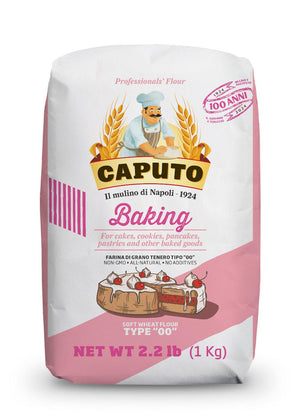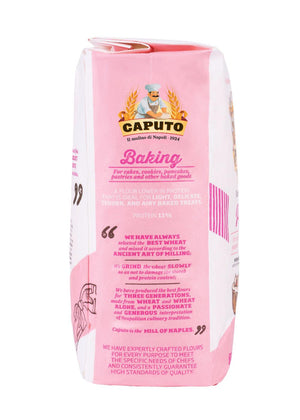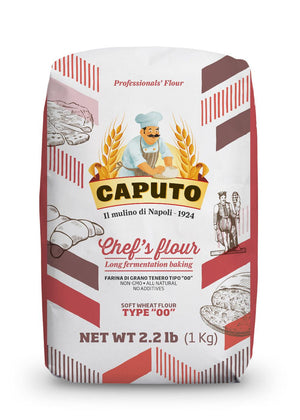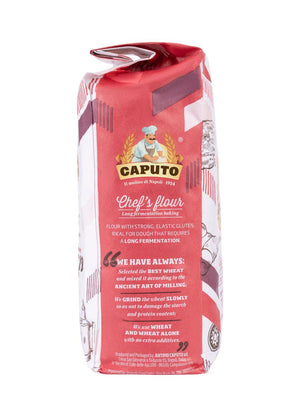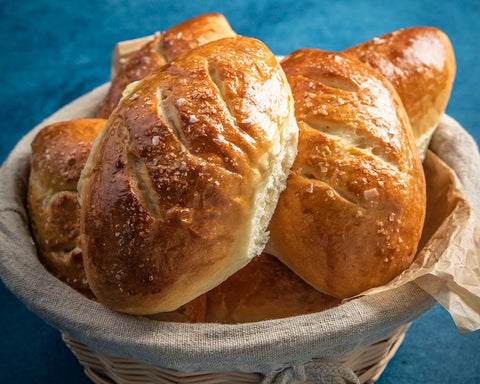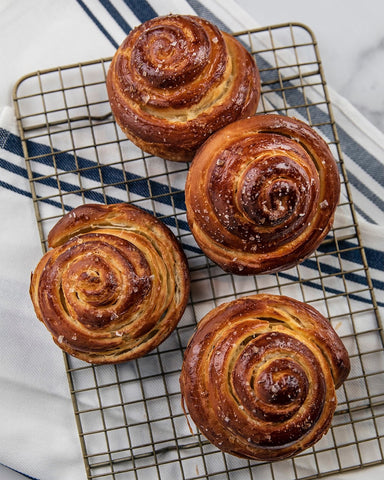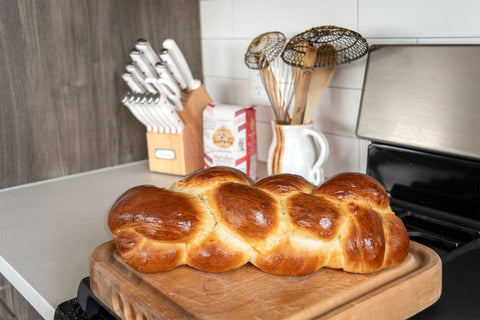
Homemade Croissants
Roll up your sleeves and take on Homemade Croissants with the help of Caputo “00” Flour. These light, buttery, and flaky croissants unlock the secret to bakery-level perfection, right from your home kitchen.
- Yield: 10-12
- Prep Time: 26 hr
- Cook Time: 16 min

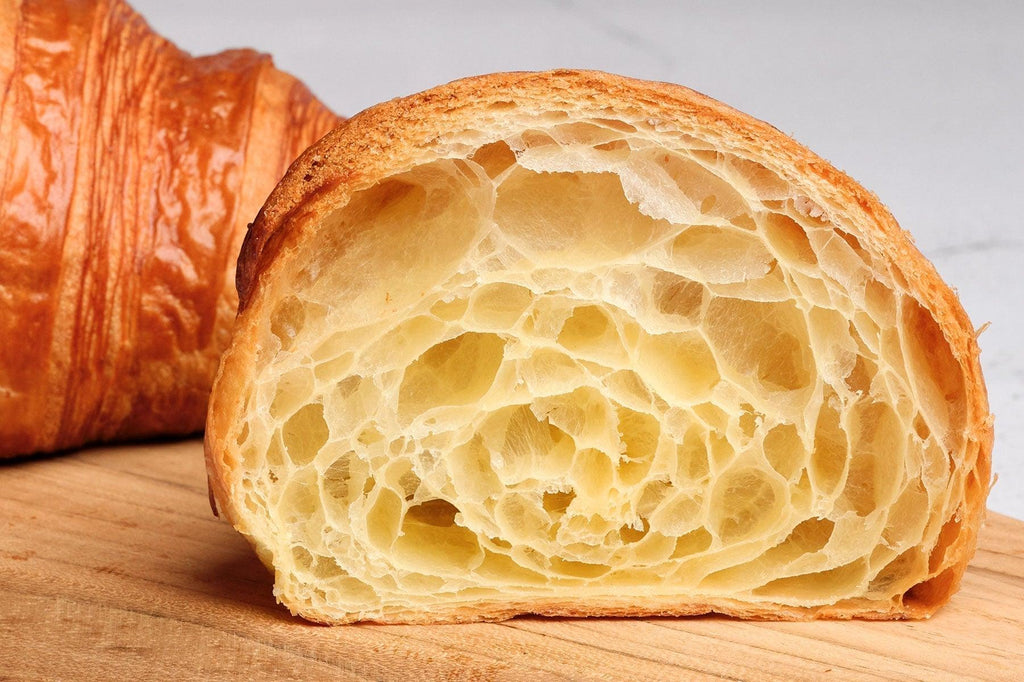
Ingredients
Instructions
Mixing the dough
- Measure all the dough ingredients.
- Place Caputo “00” Chef’s Flour or Caputo “00” Baking Flour, sea salt, instant yeast, diastatic malt powder, granulated sugar, and butter in the bowl of a stand mixer fitted with a dough hook attachment. On speed 1, slowly pour in milk and water and mix for 7 minutes. Turn the speed up to 2 and mix for 2 more minutes until combined.
- Remove the dough from the mixer and place it in a lightly oiled bowl with a lid or plastic wrap.
- Let the dough rest and ferment for one hour at room temperature.
- After one hour, lay your dough onto a surface dusted with Caputo “00” Flour, and form into a rectangle. Fold into thirds, turn 90 degrees, and fold in thirds again. Wrap the dough in plastic wrap and form it into a square.
- Place in refrigerator for at least 1 hour, up to 4 hours.
Prepare the Butter Block for Laminating
- Measure the butter and place it in between two pieces of parchment paper lightly dusted with Caputo “00” Flour.
- Using a rolling pin, roll out and press into a 3.5 x 3.5" (9 x 9 cm) square.
- Refrigerate for at least 30 minutes, or until ready to laminate the dough.
Laminate the Dough
- The goal is to create distinct layers of butter and dough without the butter melting into the dough during the process. Keeping the dough and butter cool and unbroken through lamination is essential.
- Croissants typically have 25-55 layers (12-27 layers of butter), achieved with a combination of folds. Fewer layers will mean a different texture (less tender, chewier, with more defined layers). Too many layers bring a risk of the butter getting too thin and melting into the dough.
- We recommend using the 25-layer method with Caputo “00” Baking Flour and the 55-layer method with Caputo “00” Chef’s Flour. Learn more in the Notes section beneath the recipe.
1st roll out – Encasing the butter in dough. 3 layers (1 butter layer/ 2 dough layers)
- Remove the dough from the refrigerator and plastic.
- Roll out the cold dough into a square 5 x 5" (12.7 x 12.7 cm).
- Remove the parchment paper from the butter and place the square of butter in the center of the square of dough. Wrap the dough around the butter, until it is completely covered and gently pinch closed.
- Using a knife, horizontally cut off the folded edges of the dough to allow for even layering when rolling out.
- Cover in plastic, place seam down, and refrigerate for at least 30 minutes, allowing the dough and butter to rest and become the same temperature.
25-layer method (12 butter/ 13 dough): Recommended to use with Caputo “00” Baking Flour
- Roll out the dough to approx. 1/3 of an inch (8mm).
- Fold the dough in half – this will give you 5 layers (2 butter / 3 dough).
- Refrigerate the dough for 30 minutes.
- Turn the dough 90 degrees (perpendicular) from the previous fold direction, and roll out the dough to approx. 1/3 of an inch (8mm).
- Fold the dough in half – this will give you 9 layers (4 butter / 5 dough).
- Refrigerate the dough for 30 minutes.
- Turn the dough 90 degrees (perpendicular) from the previous fold direction, and roll out the dough to approx. 1/3 of an inch (8mm).
- Fold the dough into thirds – this will give you 25 layers (12 butter / 13 dough).
- Cover in plastic and rest again for at least 30 minutes in the refrigerator before final roll out.
55-Layer method (27 butter/ 28 dough): Recommended to use with Caputo “00” Chef’s Flour
- Roll out the dough to approx. 1/3 of an inch (8mm).
- Fold the dough into thirds – this will give you 7 layers (3 butter / 4 dough).
- Refrigerate the dough for 30 minutes.
- Turn the dough 90 degrees (perpendicular) from the previous fold direction, and roll out the dough to approx. 1/3 of an inch (8mm).
- Fold the dough into thirds– this will give you 19 layers (9 butter / 10 dough).
- Refrigerate the dough for 30 minutes.
- Turn the dough 90 degrees (perpendicular) from the previous fold direction, and roll out the dough to approx. 1/3 of an inch (8mm).
- Fold the dough into thirds – this will give you 55 layers (27 butter / 28 dough).
- Cover in plastic and rest again for at least 30 minutes in the refrigerator before final roll out.
Final Roll Out
- Remove the dough from the refrigerator and plastic.
- Roll out to 1/8" thick (3mm).
Divide, Shape, and Ferment Overnight
Classic Crescent Shape:
- Using a wheel cutter or chef’s knife, cut isosceles triangles 9" (23cm) x 4.5" (11.5cm)
- Roll the short side towards the point.
- Place croissants on a parchment-lined baking sheet and be sure to leave space in between them to proof.
- Cover the croissants in plastic wrap to prevent drying out.
- Place croissants in the refrigerator overnight—12-18 hours.
Proofing
- A warm, humid final proof is ideal for croissants, around 80% humidity, between 80-90°F. If a proofer is not available, croissants may be proofed at room temperature, covered in plastic to prevent the exterior from drying out; it will just take longer.
- Insider tip: You also proof at home in your home oven. If you turn on the oven light and leave the door closed, this will generate an environment of about 80-90°F.
- Proofer uncovered at 80°F (26.6°C) with 80% humidity—approx. 2 to 2.5 hours.
- Room temperature covered 68-70°F (20-21°C)—approx. 3.5-5 hours.
- When adequately proofed, the croissants will increase in volume by approx. 2X. Gently press the exterior with your fingertip; if the dough slowly springs back they are ready.
Egg Wash
- After the final proof and before baking, apply egg wash with a pastry brush. 100% egg will caramelize quickly in the oven, yielding a dark, shiny finish. A ratio of 50% egg to 50% water will yield a lighter and less shiny finish. You can choose whichever suits you!
Baking in Convection Oven
- Preheat oven to 385°F.
- Bake for 13-16 minutes or until the desired color is achieved.
- Serve, enjoy, and impress all your friends and family!
Notes:
Key Flour Differences:
- Using Caputo “00” Chef’s Flour will yield a chewier croissant and a stronger dough, thus why we recommend the 55-layer process.
- Using Caputo “00” Baking Flour will yield a lighter and more delicate croissant because it has a lower protein content of 11%. This is why we recommend the 25-layer process.
- Both flours will yield flaky, buttery, and delicious croissants. The choice of flour is the bakers' preference.
What is Diastatic Malt?
- Diastatic malt contains diastase enzymes, which break down starches into simpler carbohydrates. It aids in the browning of crust, as well as the sweetness of yeasted bakes. It acts as a food for yeast, which can aid in oven spring, yielding a loftier loaf or roll, as well as a more tender, even crumb.
Why European-style butter?
- It has a higher fat content/less water and is preferred in croissant baking. It is more pliable, easier to roll out, and will improve flavor and texture.
Reminder:
- Croissants are a challenging pastry! Do not be discouraged; these take lots of practice to perfect and careful attention to get just right.

